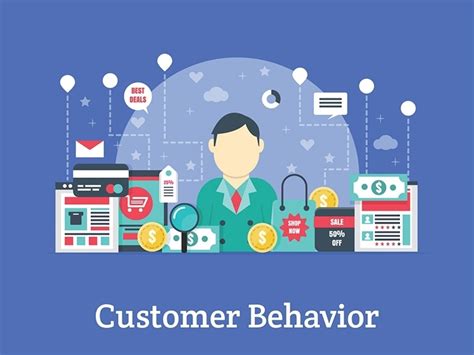In today’s rapidly evolving market, understanding consumer behavior is crucial for businesses to stay competitive and relevant. As a market research analyst, you play a pivotal role in unraveling the intricacies of consumer behavior and providing valuable insights for strategic decision making. This blog post will delve into the multifaceted aspects of consumer behavior research, including the importance of understanding consumer behavior, various research techniques, and the impact of psychological and cultural influences. We will also explore the role of social media in shaping consumer decision-making and the significance of evaluating consumer purchase patterns. Furthermore, we will discuss how utilizing consumer behavior insights can inform and enhance marketing strategies, as well as predict future consumer trends. By the end of this post, you will have a comprehensive understanding of the role of a market research analyst in interpreting consumer behavior and its implications for business success.
Table of Contents
Role of a Market Research Analyst
In today’s competitive business environment, the role of a market research analyst is more crucial than ever. These professionals are responsible for gathering and analyzing data to help companies understand market trends, consumer preferences, and competitive landscapes. They play a critical role in informing strategic business decisions and identifying opportunities for growth.
Market research analysts utilize a variety of quantitative and qualitative research methods to gather data, including surveys, interviews, focus groups, and statistical analysis. They are skilled in interpreting large volumes of information and extracting meaningful insights to guide marketing, product development, and sales strategies.
Furthermore, the psychological and cultural influences on consumer behavior are also important considerations for market research analysts. By understanding these factors, they can provide valuable recommendations on how to tailor products, messaging, and promotions to resonate with target audiences.
Ultimately, the impact of social media on consumer decision making has added another layer of complexity to the role of market research analysts. They must stay abreast of trends in digital and social media marketing to effectively assess consumer sentiments and behaviors in online environments.
Importance of Understanding Consumer Behavior
Understanding consumer behavior is crucial for any business looking to succeed in the market. Consumer behavior refers to the study of how individuals make decisions about the purchase, use, and disposal of goods and services. By understanding these behaviors, businesses can tailor their products and marketing strategies to meet the needs and desires of their target customers.
One of the key aspects of understanding consumer behavior is being able to predict how consumers will react to different marketing efforts. By studying their behaviors, businesses can anticipate the impact of certain strategies and adjust their tactics accordingly. This can help them avoid costly mistakes and ensure that their efforts are more effective.
In addition, understanding consumer behavior can also help businesses identify new trends and opportunities in the market. By analyzing patterns and preferences, businesses can spot emerging trends and capitalize on them before their competitors. This can give them a significant edge in the market and help them stay ahead of the competition.
Furthermore, understanding consumer behavior can also assist businesses in innovating and developing new products and services. By understanding what consumers want and need, businesses can create offerings that are in line with their preferences, leading to higher levels of satisfaction and increased sales.
Consumer Behavior Research Techniques
When it comes to understanding consumer behavior, research techniques play a crucial role in gathering valuable insights. Consumer behavior research techniques encompass a wide range of methods used to study and analyze how individuals make purchasing decisions, what influences their choices, and how they respond to marketing efforts. These techniques provide marketers and businesses with the necessary data to develop effective strategies and tailor their offerings to meet the needs and preferences of their target audience.
One of the most commonly used consumer behavior research techniques is surveys and questionnaires. These tools allow researchers to collect quantitative data by asking consumers about their attitudes, preferences, and buying habits. By analyzing the responses, businesses can gain a better understanding of consumer motivations and preferences, which can be used to inform product development and marketing campaigns.
Observational research is another important technique for studying consumer behavior. This method involves directly observing consumers in their natural environment, such as in stores or online shopping platforms. By watching how consumers browse, compare products, and make purchase decisions, businesses can gain valuable insights into their behavior and preferences.
Focus groups are also widely used in consumer behavior research. These small group discussions provide researchers with qualitative data by allowing participants to express their opinions, beliefs, and experiences. By facilitating open discussions, businesses can gain in-depth insights into consumer perceptions, attitudes, and emotions towards products and brands.
Quantitative vs. Qualitative Research Methods
When it comes to research methods, there are two main approaches that are commonly used: quantitative and qualitative. Quantitative research focuses on gathering numerical data and generalizing it across groups of people or to explain a particular phenomenon. It often involves surveys, experiments, or statistical analysis to draw conclusions. On the other hand, qualitative research is more concerned with understanding the underlying reasons, motivations, and opinions behind a particular behavior. This approach often involves in-depth interviews, focus groups, or content analysis to gain a deeper understanding of a particular topic or issue.
One of the main differences between the two methods is the type of data that is collected. Quantitative research collects data in the form of numbers, which can be easily analyzed using statistical techniques. This allows researchers to identify patterns, trends, and correlations within the data. In contrast, qualitative research collects data in the form of words, images, or objects, which requires a more interpretive and subjective analysis. This can provide rich, detailed insights into the complexities of human behavior and the context in which it occurs.
Another key distinction between the two methods is the way in which the research is conducted. Quantitative research often involves a large sample size and standardized data collection methods to ensure reliability and validity. It aims to produce results that are generalizable and can be replicated in other settings. On the other hand, qualitative research typically involves a smaller, more targeted sample and relies on the researcher’s ability to interpret and make sense of the data. It aims to provide a deeper, contextual understanding of a phenomenon or behavior.
It’s important to note that both quantitative and qualitative research methods have their own strengths and limitations. Depending on the research question, objectives, and context, researchers may choose to use either approach or a combination of both to gain a comprehensive understanding of the topic at hand. By understanding the differences between these two methods, researchers can make informed decisions about which approach best suits their research needs.
Psychological Factors Influencing Consumer Behavior
When it comes to understanding consumer behavior, it is crucial to consider the psychological factors that influence the decision-making process. These factors can have a significant impact on how individuals perceive and respond to marketing strategies, product offerings, and brand messaging.
One of the key psychological factors that influence consumer behavior is perception. How consumers perceive a product or brand can greatly affect their purchasing decisions. This includes how they interpret the features and benefits of a product, as well as how they perceive the overall value and quality. Marketers must be aware of the various factors that can shape consumer perception, including past experiences, cultural influences, and personal biases.
Motivation is another important psychological factor that plays a role in consumer behavior. Understanding what drives individuals to make purchasing decisions can help marketers tailor their messaging and offerings to better meet consumer needs and desires. Whether it’s the desire for status, the need for convenience, or the urge to satisfy a specific craving, motivation can heavily influence consumer choices.
Emotional factors also play a significant role in shaping consumer behavior. The emotions that consumers associate with a brand or product can have a powerful impact on their decision-making process. Whether it’s feelings of trust, excitement, nostalgia, or fear, these emotions can sway purchasing decisions and brand loyalty. Marketers must be attuned to the emotional triggers that resonate with their target audience in order to create effective marketing campaigns.
Cultural Influences on Consumer Behavior
When it comes to understanding consumer behavior, it’s crucial to consider the cultural influences that shape individuals’ buying decisions. Culture plays a significant role in determining how consumers perceive products, brands, and marketing messages. Marketers must be aware of the cultural differences that exist within their target markets in order to effectively tailor their strategies.
One of the major cultural influences on consumer behavior is the values and beliefs held by a particular society. These can greatly impact what individuals prioritize in their purchasing decisions. For example, in some cultures, community and family are valued above all else, leading to a greater emphasis on products that facilitate social interactions.
Moreover, cultural influences also extend to language and communication styles. Marketers must be mindful of the language barriers that exist within different cultural groups and ensure that their messaging is sensitive to these differences. Additionally, cultural symbols, rituals, and traditions can significantly influence consumer behavior, as individuals may associate particular products with their cultural identity.
Understanding the cultural influences on consumer behavior allows marketers to create more relevant and impactful strategies. By acknowledging and respecting the diversity of cultural perspectives, businesses can establish deeper connections with their target audience and foster brand loyalty.
Impact of Social Media on Consumer Decision Making
Social media has become a powerful tool for influencing consumer decision making in today’s digital age. With the rise of platforms like Facebook, Instagram, and Twitter, consumers are constantly bombarded with advertisements, product recommendations, and influencer endorsements that shape their purchasing behaviors.
One of the key impacts that social media has on consumer decision making is the ability to create brand awareness and recognition. Through strategic social media marketing, companies can reach a wider audience and increase their visibility, ultimately influencing consumers to consider their products or services when making a purchase decision.
Furthermore, social media provides a platform for consumers to engage with brands directly, whether it’s through commenting on posts, sharing reviews, or participating in online discussions. This direct interaction allows companies to gain valuable insights into consumer preferences and behaviors, which can then be used to tailor their marketing strategies and product offerings.
It’s important for businesses to recognize the impact of social media on consumer decision making and adapt their marketing efforts accordingly. By leveraging the power of social media, companies can effectively influence consumers’ purchasing habits and drive sales, ultimately leading to a competitive edge in the market.
Evaluating Consumer Purchase Patterns
When it comes to understanding consumer behavior, one key aspect to consider is evaluating consumer purchase patterns. This involves analyzing the buying habits of customers, including the products they purchase, the frequency of their purchases, and the channels through which they make their purchases.
By studying consumer purchase patterns, businesses can gain valuable insights into the preferences and tendencies of their target audience. This information can be used to make informed decisions about product development, marketing strategies, and pricing.
There are various methods for evaluating consumer purchase patterns, including surveying customers, analyzing sales data, and conducting market research. These techniques can provide businesses with a comprehensive understanding of the factors that influence consumer purchasing decisions.
Ultimately, evaluating consumer purchase patterns is essential for businesses looking to stay competitive in the market and tailor their offerings to meet the needs and desires of their customers.
Predicting Future Consumer Trends
In today’s fast-paced and ever-changing market, predicting future consumer trends is crucial for businesses to stay ahead of the competition. By analyzing current market data and consumer behavior, companies can gain valuable insights into what the future holds for their target audience.
One method of predicting future consumer trends is through the use of predictive analytics. This involves using historical data and statistical algorithms to forecast future trends and behavior. By identifying patterns and correlations in data, businesses can make informed decisions about product development, marketing strategies, and overall business planning.
Another important factor in predicting future consumer trends is staying informed about technological advancements and societal changes. As technology continues to evolve at a rapid pace, consumer behavior and expectations also change. By keeping abreast of technological innovations and societal shifts, businesses can anticipate how these changes will impact consumer behavior in the future.
Additionally, collaborations with market research analysts can provide valuable insights into predicting future consumer trends. Through consumer surveys, focus groups, and other research methods, analysts can uncover emerging trends and preferences among target audiences. By working closely with market research professionals, businesses can gain a deep understanding of evolving consumer behavior.
Utilizing Consumer Behavior Insights for Marketing Strategies
Understanding consumer behavior is crucial for developing effective marketing strategies. By gaining insights into the psychological factors influencing consumer behavior, marketers can tailor their approach to better appeal to their target audience.
One way to utilize consumer behavior insights is by analyzing consumer purchase patterns. By understanding when, where, and how consumers make purchasing decisions, marketers can optimize their marketing efforts, such as timing promotions or adjusting product placement.
Another aspect to consider is the cultural influences on consumer behavior. Different cultures have unique values, beliefs, and customs that can impact their purchasing decisions. By recognizing these cultural differences, marketers can adapt their strategies to resonate with diverse consumer groups.
Furthermore, the impact of social media on consumer decision making cannot be overlooked. Social media platforms provide a wealth of data on consumer preferences and behavior, which can be leveraged to create targeted marketing campaigns that speak directly to the interests and needs of consumers.





